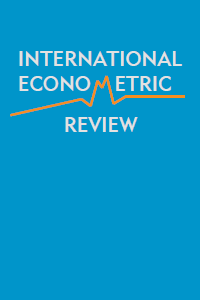What Now? Some Brief Reflections on Model-Free Data Analysis
What Now? Some Brief Reflections on Model-Free Data Analysis
___
- Anderson, T.W. (1958). An Introduction to Multivariate Statistical Analysis, First Edition. New York: John Wiley and Sons.
- Berk, R.A. (2005). Randomized Experiments as the Bronze Standard. Journal of Experimental Criminology, 1(4): 417-433.
- Berk, R.A. (2008). Statistical Learning from a Regression Perspective, New York: Springer.
- Bishop, C.M. (2006). Pattern Recognition and Machine Learning. New York: Springer.
- Brown, L.D., M.L. Eaton, D.A. Freedman, S.P. Klein, R.A. Olshen, K.W. Wachter, M.T. Wells and D. Ylvisaker (1999). Statistical Controversies in Census 2000. Jurimetrics, 39: 347-375.
- Boullicaut, J-F., and C. Masson (2005). “Data Mining Query Languages”, (in: O. Maimon and L. Rokach -Ed. The Data Mining and Knowledge Discovery Handbook), New York: Springer.
- Cleveland, W.E. (1993). Visualizing Data. Summit, Jew Sersey: Hobart Press.
- Cook, D., Swayne, D.F., Buja, A., and T. Lang (2007). Interactive Dynamc Graphics and Data Analysis. New York: Springer.
- Dasu, T., and T, Johnson (2003). Exploratory Data Mining and Data Cleaning. New York: John Wiley and Sons.
- Diaconis, P. (1985). “Theories of Data Analysis: From Magical Thinking through Classical Statistics”. (in: D.C. Hoaglin, F. Mosteller, and J. Tukey -Ed., Exploring Data Tables, Trends, and Shapes), New York: John Wiley and Sons.
- Freedman, D.A. (2004). On Specifying Graphical Models for Causation, and the Identification Problem. Evaluation Review, 26: 267-293.
- Freedman, D.A. (2005). Statistical Models Theory and Practice. Cambrige University Press.
- Freedman, D.A. (2006). Statistical Models for Causation: What Inferential Leverage Do They Provide? Evaluation Review, 30: 691-713.
- Freedman, D.A. (2008a). Randomization Does not Justify Logistic Regression. Statistical Science, 23: 237-249.
- Freedman, D.A. (2008b). On Regression Adjustments to Experimental Data. Advances in Applied Mathematics, 40: 180-193.
- Freedman, D.A. and R.A. Berk (2008). On Weighting Regressions by Propensity Scores. Evaluation Review, 32: 392-409.
- Freedman, D.A. and P. Humphreys (1999). Are There Algorithms That Discover Causal Structure? Synthese, 121: 29-54.
- Freedman, D.A., P.B. Stark and K.W. Wachter (2001). A Probability Model for Census Adjustment. Mathematical Population Studies, 9: 165-180.
- Freedman, D.A. and K.W. Wachter (2001). Census Adjustment: Statistical Promise or Statistical Illusion? Society, 39: 26-33.
- Freedman, D.A. and K.W. Wachter (2003). “On The Likelihood of Improving the Accuracy of The Census Through Statistical Adjustment”. (in D. R. Goldstein -Ed., Science and Statistics: A Festschrift for Terry Speed. Institute of Mathematical Statistics Monograph 40: 197-230.)
- Gifi, A. (1990). Nonlinear Multivariate Analysis, New York: John Wiley and Sons.
- Hastie, T., R. Tibshirani and J. Friedman (2009). The Elements of Statistical Learning, Second Edition. New York: Springer.
- Heckman, J. (2000). Causal Parameters and Policy Analysis in Economics: A Twentieth Century Retrospective. Quarterly Journal of Economics, 88 (2): 47-97.
- Hoaglin, D.C., F. Mostellor and J. Tukey (2006), Understanding Robust and Exploratory Data Analysis, Wiley Classics Library. New York: John Wiley and Sons.
- Hoaglin, D.C., F. Mostellor and J. Tukey (2000). Exploring Data Tables, Trends, and Shapes, Wiley Classics Library. New York: John Wiley and Sons.
- Höppner, F. (2005). “Association Rules”, (in O. Maimon and L:. Rokach -Ed., The Data Mining and Knowledge Discovery Handbook), New York: Springer.
- Imbens, G. (2004). Nonparametric Estimation of Average Treatment Effects Under Exogeneity: A Review. The Review of Economics and Statistics, 86 (1): 4-29.
- Imbens, G. and T. Lemieux (2008). Regression Discontinuity Designs: A Guide to Practice. Journal of Econometrics, 142: 611-614.
- King, R.D., J. Rowland, S.G. Oliver, M. Young, W. Aubrey, E. Byrne, M. Liakata, M. Markham, P. Pir, L.N. Soldatova, A. Sparkes, K.K. Whelan and A. Clare (2009). The Automation of Science. Science, 324 (3): 85-89.
- Leeb, H. and B.M. Pötscher (2005). Model Selection and Inference: Facts and Fiction, Econometric Theory, 21: 21–59.
- Leeb, H. and B.M. Pötscher (2006). Can one Estimate the Conditional Distribution of Post- Model-Selection Estimators? The Annals of Statistics, 34 (5): 2554–2591.
- Leeb, H. and B.M. Pötscher (2008). “Model Selection”, (in T.G. Anderson, R.A. Davis, J.P. Kreib, and T. Mikosch -Ed., The Handbook of Financial Time Series), New York, Springer: 785–821.
- Maimon, O., and L. Rokach (2005). The Data Mining and Knowledge Discovery Handbook. New York: Springer.
- Rubin, D.B. (2008). For Objective Causal Inference, Design Trumps Analysis. Annals of Applied Statistics, 2 (1): 808-840.
- Schmidt, M., and H. Lipson (2009). Distilling Free-Form Natural Laws from Exeprimental Data. Science, 324 (8): 81-85.
- Tukey, J. (1977). Exploratory Data Analysis. Reading, MA: Addison -Wesley.
- Wachter, K.W. and D.A. Freedman (2000). The Fifth Cell: Correlation Bias in U.S. Census Adjustment. Evaluation Review, 24: 191-211.
- Wachter, K.W. and D.A. Freedman (2000). Measuring Local Heterogeneity with 1990 U.S. Census Data. Demographic Research, 3 (10): 1-22.
- Wachter, K.W. and D.A. Freedman (1996). Planning for the Census in the Year 2000. Evaluation Review, 20: 355-377.
- ISSN: 1308-8793
- Başlangıç: 2009
- Yayıncı: Ekonometrik Araştırmalar Derneği
What Now? Some Brief Reflections on Model-Free Data Analysis
A Minimum Power Divergence Class of CDFs and Estimators for the Binary Choice Model
Ron MİTTELHAMMER, George JUDGE
Comments on 'Limits of Econometrics' by David Freedman
Information Spillover, Volatility and the Currency Markets
Walid Ben OMRANE, Christian M. HAFNER
Asad Zaman, In Memoriam David Freedman (March 5, 1938 - October 17, 2008)
